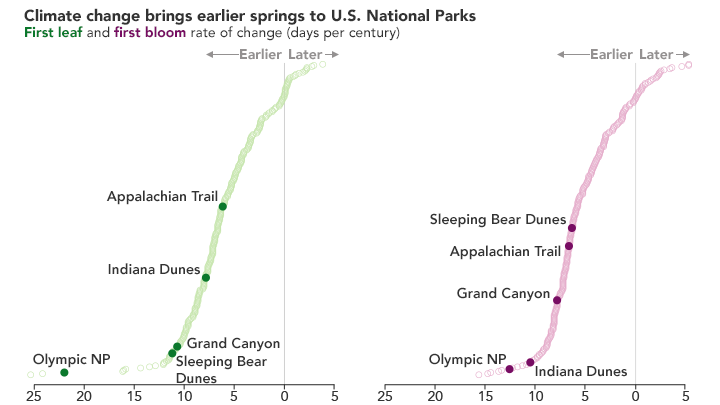

This spring, the cherry trees around the Tidal Basin, southwest of the National Mall in Washington, D.C., are reaching peak bloom in early April 2018—timing that is in line with the 96-year average. After a warm February, cool March temperatures confounded models that had predicted the bloom to occur earlier than usual. That’s not surprising, as temperature plays a crucial role in bloom timing.
But over the longer term, climate change is causing spring to begin earlier and earlier across the United States. These maps reveal just how much earlier spring is arriving in National Parks across the country. The data were published in 2016 by ecologists from the National Park Service, working in collaboration with colleagues at other agencies and institutions.
The first map shows the rate of change (days per century since 1901) of “first leaf”—the date at which leaves first appear from buds. The second map shows the same rate of change for “first bloom,” the average date when blooms appear. Combined, the two indices provide a way for ecologists to identify how vegetation is responding to warming temperatures.
“Climate changes are affecting resources across the entire range of National Parks,” said John Gross a climate change ecologist with the National Park Service. “Earlier springs, as indicated by leaf and flowering dates, is one of the most obvious and easily understood effects of climate change.”
Of the 276 parks in the study (including Alaska, not pictured), about three-quarters of them are experiencing earlier springs. More than half are experiencing “extreme” early springs; that is, recent springs are among the earliest ever observed—and in many cases are wholly unprecedented—compared to the past 112 years. The charts below show that indeed, the vast majority of parks are experiencing first leaf and first bloom earlier than usual. This means that most parks are already experiencing and responding to climate-driven changes.

But as the maps also show, the magnitude of the change varies with location. Early blooming is evident in the swath of purple stretching from the southern to northeastern United States along the Appalachian Trail. Early leafing is quite evident in the southwestern part of the country, such as Grand Canyon National Park. Here, the long-term changes mean that spring is now arriving nearly two weeks earlier than it did in 1901.
Still other parks, such as Olympic National Park, are both blooming and leafing out earlier than normal. Conversely, some areas of the southeastern United States are not seeing much change at all; that region experienced less warming in the second half of the 20th Century.
Earlier springs have implications for how national parks are managed. The Cherry Blossom festival in Washington, D.C., for example, has been lengthened to a multi-week event, making it more likely that the timing of the festival and peak bloom overlap. As the timing of spring has advanced, parks also have had to adjust the timing of management actions, which include hiring seasonal staff, opening park facilities, and initiating control of pests and invasive plants.
According to Gross, park visitors are highly attuned to the beauty of the spring—from the emergence of buds to colorful flowers that emerge—and can observe for themselves how warming is changing the seasonality of parks. An earlier spring can affect the relationships between plants and pollinators, the wildlife that migrate in response to the greening of the plants they eat, and the return of birds that rely on the emergence of insects to feed their young.
“Changes in leaf and flowering dates have broad ramifications for nature,” Gross said. “Pollinators, migratory birds, hibernating species, elk, and caribou all rely on food sources that need to be available at the right time. Warming climates have disrupted these patterns, causing hardships for the animals and people that rely on them.”
NASA Earth Observatory images by Joshua Stevens, using data courtesy of Monahan, William B., et al. (2016). Story by Kathryn Hansen.
Image of the Day Land Remote Sensing
In National Parks across the United States, recent springs are among the earliest ever observed compared to the past 112 years.
Image of the Day for April 6, 2018